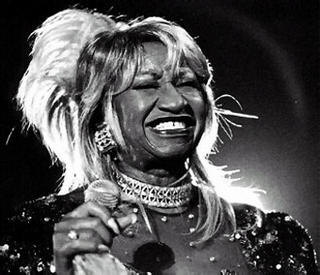ultimately, what the rumba contributes to the deadly challenging course, intercourse, and discourse of the marginal is a tradition of awareness tucked away in a poetics of desperation that is capable of generating a subversive hip poetics both at the national and international level. (108)His reference to the "desperation" of those who use this often seedy, ostensibly demeaning dance to establish some sense of place in the world indicates that Piedra's intent is far from simple celebration: "the rumba is not, per se, a solution to feminist calls for liberation; it remains a choice and a challenge for certain women who pay dearly for it" (108).
Hence the rumba's "heroines" (from the now anonymous prostitutes who popularized the dance in Cuba during the 1920s and 1930s to Carmen Miranda, Celia Cruz, or Gloria Estefan) are also "'martyrs' of a desperate language of convulsive bits, beats, and bites" (113).

"In the realm of the rumba," Piedra claims,
women superficially hyperact, and thus subversively claim for themselves and counteract demeaning traits that have been traditionally assigned to, revoked from, and theatrically imposed upon them by a predominantly male-run establishment. (124)In other words, Piedra's argument is (not so far from Diana Taylor's) about the ambivalent possibilities of performance, of what he here terms "hyperact[ing]," to put into sharp, and so critical, relief the gender roles to which subaltern women are condemned.
Encoded within the rumba, or rather encoded within its masculinist code as "a hidden code within another code" (122), Piedra finds embodied self-assertion. The dance's characteristic jutting hip serves as "a feisty source of poetics" (96) and also warns patriarchy that, in the words of an Akan proverb, "women's violent shakings of the hips kill (that is, give them power over men)" (98). The rumba "turn[s] a meaningless body part into a signifying bodily attitude, compliance into defiance" (96).
But why "signifying"? Surely, as Piedra himself suggests when he notes the ways in which "the man's movements become the signified to the woman's signifier" (103), signification is itself the capture of affect by social order. It is precisely in so far as the dance's bodily affect is in excess of such signifying codes that a counter-code--or, better, decoding--is effected.
It is because this Afro-Latin rhythm is not exhausted either by its commercialization or by its patriarchal interpretation that it can preserve affective memories of the African deity Sikán, "a central anticolonialist source/force" and "the ultimate model for the transatlantic rumba" (120). Hence, beyond the critical distance that the fact of performance interpolates between subject and image,
the rite of the rumba advocates a performance and presence of women's rights that should be sensed rather than felt, filled, or otherwise fulfilled--that is enough reason for her not to be named or otherwise rendered obvious, readily intelligible, or easily had other than as a scornful stripper on the other side of the lights. (123)On the other hand, however, this article raises many doubts. I'm not convinced by the display of etymological roots and so rootedness that traces such a linear transmission of meaning from West Africa to the Miami Sound Machine or Carnegie Hall.
Nor am I convinced by Piedra's own refusal of the "obvious" or the "readily intelligible," his (desperate or other) attempts, by writing so allusively and eclectically, to appear himself so very "hip."
No comments:
Post a Comment